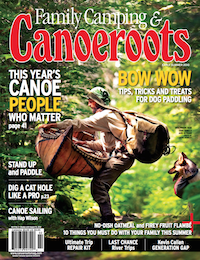It’s not that I’ve completely run out of people to paddle with, or that getting old necessarily means becoming unsociable, but I have to admit that lately my canoeing has, more often than not, gone to the dogs. When I’ve asked around the house over the last few years if there’s anybody who’d like to go for a paddle at, say, six o’clock on a frosty morning or perhaps around threeish, when a totally word-processed body needs a bit of a stretch, it’s my dogs who have most enthusiastically answered the call.
Our kids have flown the coop and my wife has a life beyond our empty nest. But the dogs are there and always keen. They make excellent ballast, they’ve learned how to sit still, enjoy the camaraderie of the canoe and never disagree with my route. Over the years, they’ve also come up with some damn good editorial suggestions as we’ve dipped along Cranberry Lake.
Turns out that there’s something of a Canadian tradition for dogs as trail companions. Ask any aboriginal person, especially Inuit, whether they’d rather have a $250 electric bear fence alarm system or a dog in their canoe when paddling through bear country. They’ll go with the dog every time.
As long as there have been cameras and ethnologists present to press the shutter, if you look carefully in black and white archival im- agery—and it doesn’t seem to matter if you’re east, west or in the middle of the country— you’ll find a dog tucked in amongst the family and the load in bark canoe photos. Sometimes you’ll even spot dogs with panniers or drawing a little travois on the portages.
Sir George Simpson, who eventually became the governor of the Hudson’s Bay Company, followed that tradition in his first canoe journey into Athabasca country with a little canine he called Boxer. The great explorer, Alexander Mackenzie took a prodigal dog (prodigal because he lost it on the way out to the Pacific and found it on the way back) in his canoe.
CANOE CALAMITY
But stop the presses. There’s a genuine canoe calamity in progress—I fear that Canada itself is going to the dogs. Commenting in the Globe and Mail on the results of a nation-wide survey about all things Canadian, Roy MacGregor, one of this country’s great canoe champions, observed that more Canadians have sucked back an order of poutine than have been in a canoe. No wonder obesity is reaching epidemic proportions.
It’s not that Quebec’s greasy-spoon treat is dog food—although my four-legged paddling partners would be the first to agree that there’s nothing quite so delicious. But I believe our national identity should be held together by our shared love of the canoe, not a plate of french fries and sticky cheese curds slathered in thick, dark brown gravy.
This June 26 put down your plastic forks, grab your paddles and join fellow paddlers across the country in celebrating National Canoe Day.
Can’t find a paddling partner? Find someone new to take canoeing or take your dog. Let’s turn the tide on the next nationwide survey before a grey-bearded academic at the Prince Edward Island Potato Museum creates National Poutine Day.
James Raffan is the executive director of the Canadian Canoe Museum. Some of his best friends are dogs.




